Cisco UCS Virtual Interface Card 1400/14000 Series Data Sheet
Available Languages
Bias-Free Language
The documentation set for this product strives to use bias-free language. For the purposes of this documentation set, bias-free is defined as language that does not imply discrimination based on age, disability, gender, racial identity, ethnic identity, sexual orientation, socioeconomic status, and intersectionality. Exceptions may be present in the documentation due to language that is hardcoded in the user interfaces of the product software, language used based on RFP documentation, or language that is used by a referenced third-party product. Learn more about how Cisco is using Inclusive Language.
Cisco Unified Computing System overview
The Cisco Unified Computing System (Cisco UCS) is a next-generation data center platform that unites computing, networking, storage access, and virtualization resources in a cohesive system designed to reduce Total Cost of Ownership (TCO) and increase business agility. The system integrates a low-latency, lossless 10/25/40/100 Gigabit Ethernet network fabric with enterprise-class blade and rack x86-architecture servers. The system is an integrated, scalable, multichassis platform in which all resources participate in a unified management domain.
The Cisco UCS Virtual Interface Card (VIC) 1400/14000 Series (Figure 1) extends the network fabric directly to both servers and virtual machines so that a single connectivity mechanism can be used to connect both physical and virtual servers with the same level of visibility and control. Cisco VICs provide complete programmability of the Cisco UCS I/O infrastructure, with the number and type of I/O interfaces configurable on demand with a zero-touch model.

Cisco UCS VIC 1400/14000 Series
Cisco VICs support Cisco SingleConnect technology, which provides an easy, intelligent, and efficient way to connect and manage computing in your data center. Cisco SingleConnect unifies LAN, SAN, and systems management into one simplified link for rack servers, blade servers, and virtual machines. This technology reduces the number of network adapters, cables, and switches needed and radically simplifies the network, reducing complexity. Cisco VICs can support 256 Express (PCIe) virtual devices, either virtual Network Interface Cards (vNICs) or virtual Host Bus Adapters (vHBAs), with a high rate of I/O Operations Per Second (IOPS), support for lossless Ethernet, and 10/25/40/100-Gbps connection to servers. The PCIe Generation 3 x16 interface helps ensure optimal bandwidth to the host for network-intensive applications, with a redundant path to the fabric interconnect. Cisco VICs support NIC teaming with fabric failover for increased reliability and availability. In addition, it provides a policy-based, stateless, agile server infrastructure for your data center.
The VIC 1400/14000 series is designed for UCS X-Series M6 Blade Servers, B-Series M5 and M6 Blade Servers, C-Series M5 and M6 Rack Servers, and S-Series M5 Storage Servers. The adapters are capable of supporting 10/25/40/100-Gigabit Ethernet and Fibre Channel over Ethernet (FCoE). It incorporates Cisco’s next-generation Converged Network Adapter (CNA) technology and offers a comprehensive feature set, providing investment protection for future feature software releases. In addition, the VIC supports Cisco’s Data Center Virtual Machine Fabric Extender (VM-FEX) technology. This technology extends the Cisco UCS fabric interconnect ports to virtual machines, simplifying server virtualization deployment.
Cisco VIC 1440
The Cisco UCS VIC 1440 (Figure 3) is a single-port 40-Gbps or 4x10-Gbps Ethernet/FCoE capable modular LAN On Motherboard (mLOM) designed for Cisco UCS B-Series M5 and M6 Blade Servers. When used in combination with an optional port expander, the Cisco UCS VIC 1440 capabilities are enabled for two ports of 40-Gbps Ethernet. The Cisco UCS VIC 1440 enables a policy-based, stateless, agile server infrastructure that can present to the host PCIe standards-compliant interfaces that can be dynamically configured as either NICs or HBAs.
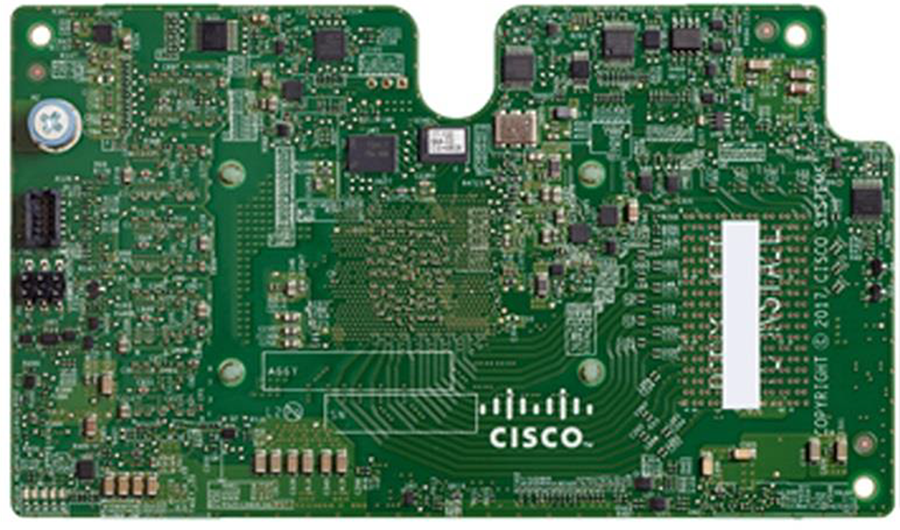
Cisco UCS VIC 1440
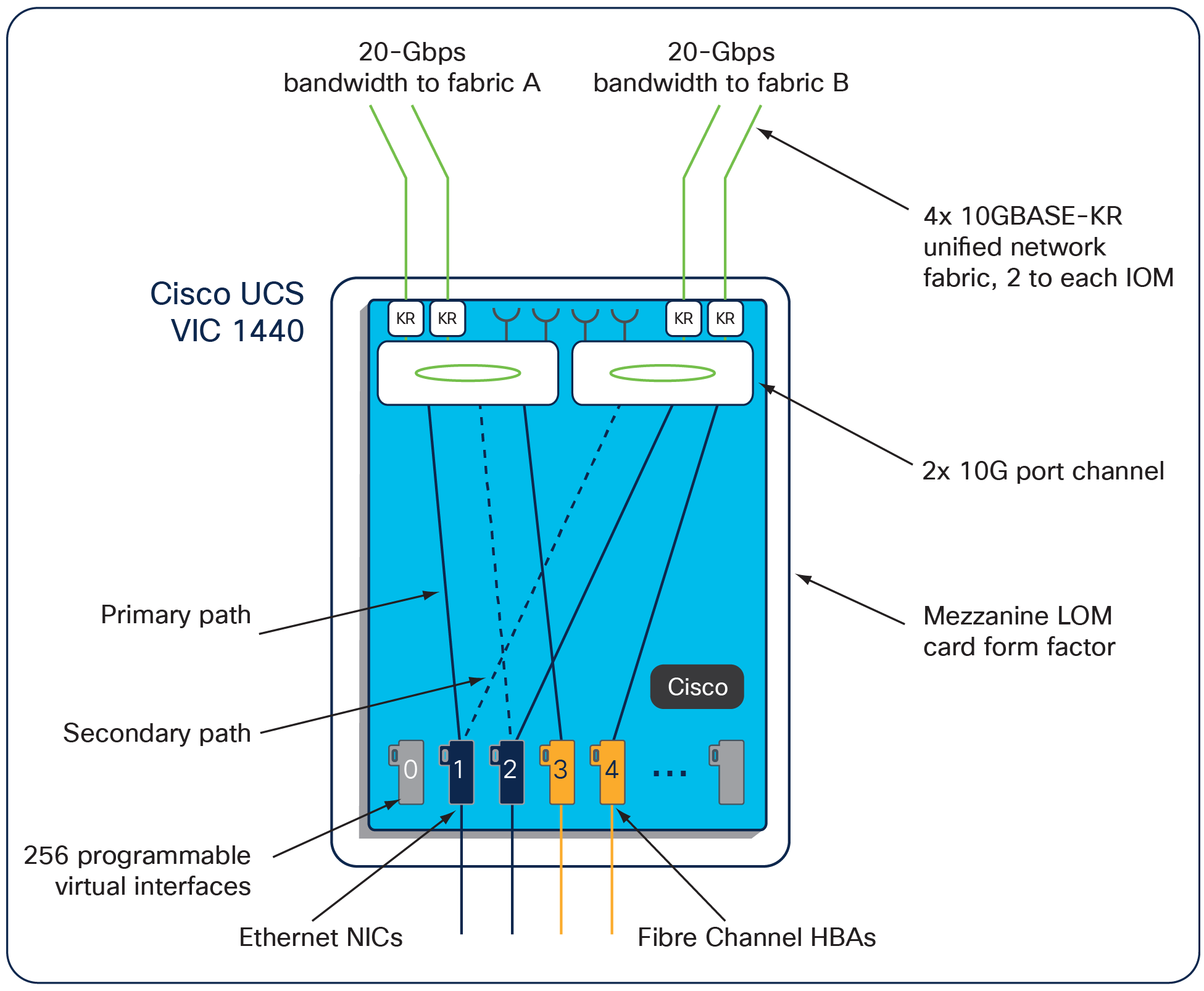
Cisco UCS VIC 1440 Infrastructure
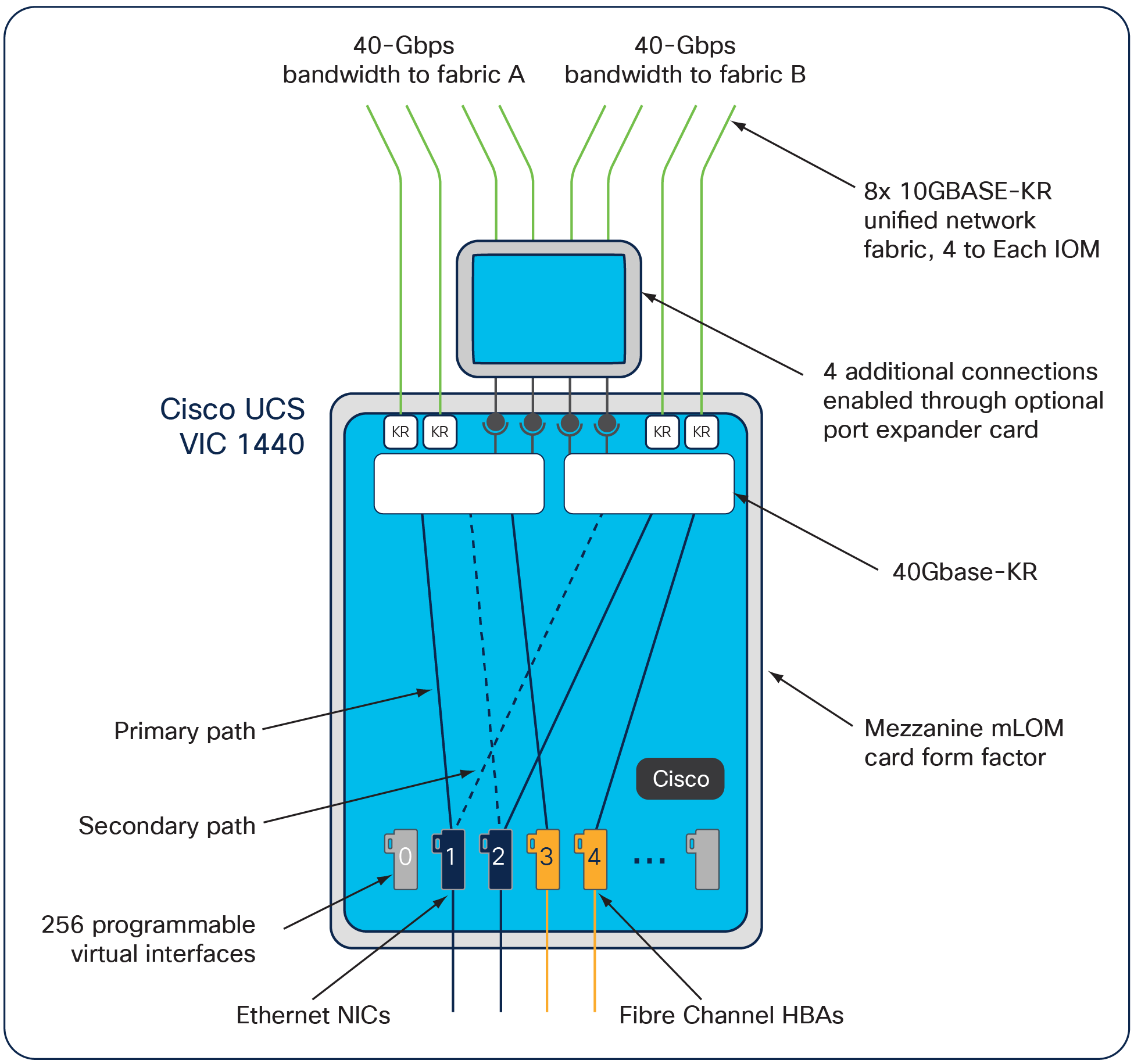
Cisco UCS VIC 1440 with Port Expander
The Cisco UCS VIC 1480 (Figure 6) is a single-port 40-Gbps or 4x10-Gbps Ethernet/FCoE capable mezzanine card (mezz) designed exclusively for Cisco UCS B-Series M5 and M6 Blade Servers. The card enables a policy-based, stateless, agile server infrastructure that can present PCIe standards-compliant interfaces to the host that can be dynamically configured as either NICs or HBAs.
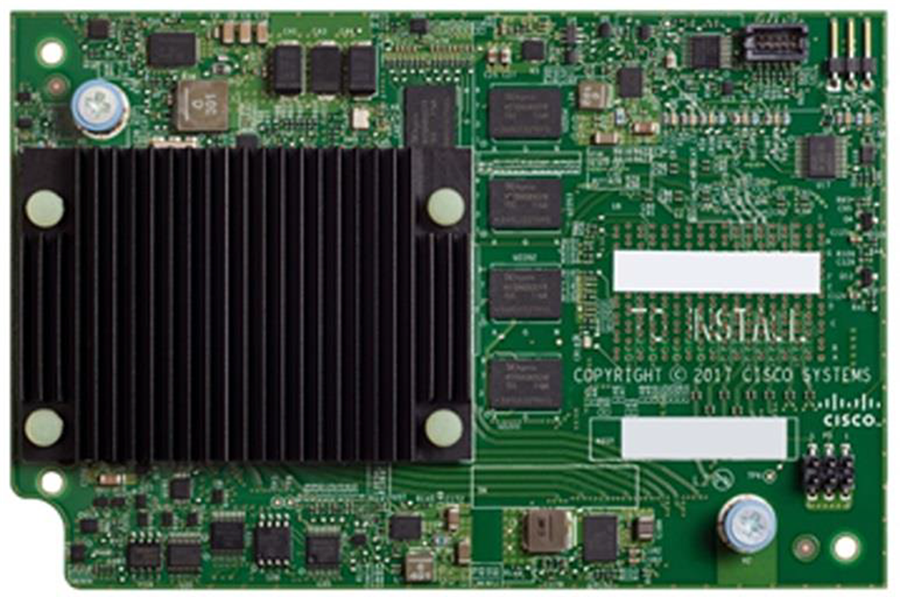
Cisco UCS VIC 1480
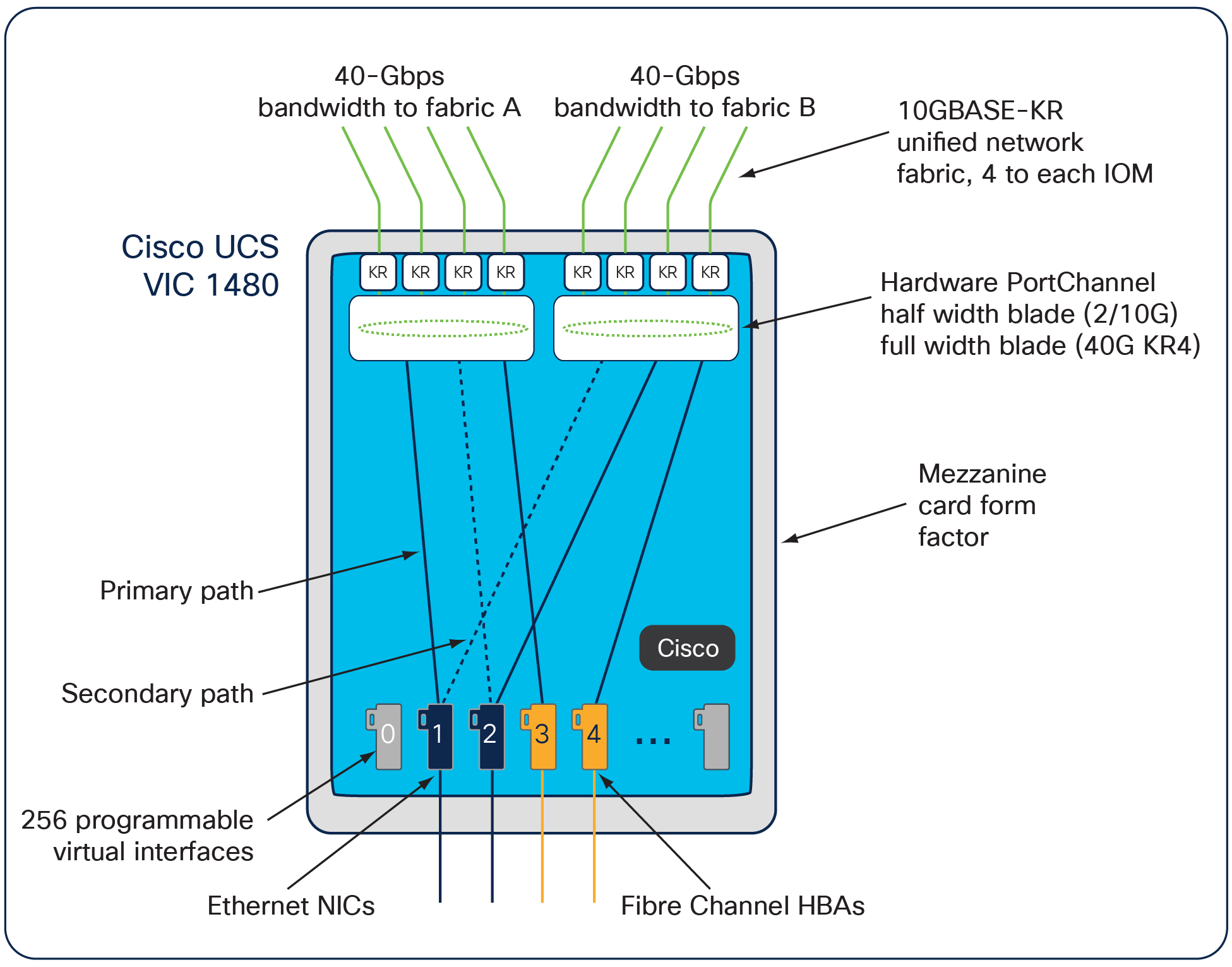
Cisco UCS VIC 1480 Infrastructure
Cisco VIC 14425
The Cisco UCS VIC 14425 (Figure 8) is a 4x25-Gbps Ethernet/FCoE capable modular LAN On Motherboard (mLOM) designed exclusively for Cisco UCS X210c M6 Compute Node. The Cisco UCS VIC 14425 enables a policy-based, stateless, agile server infrastructure that can present to the host PCIe standards-compliant interfaces that can be dynamically configured as either NICs or HBAs.
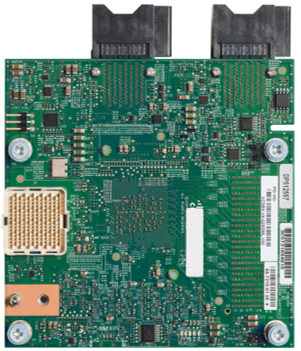
Cisco UCS VIC 14425
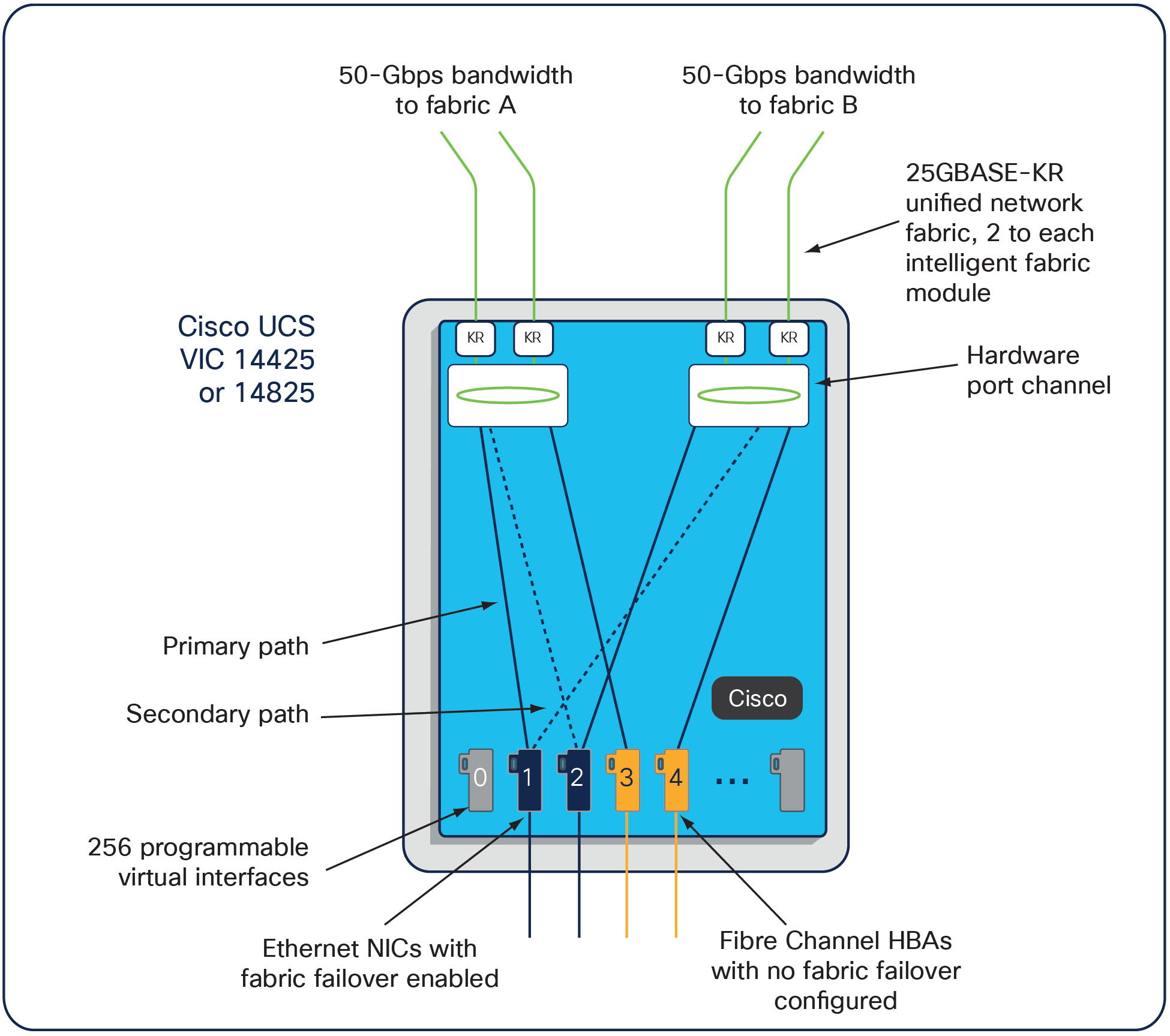
Cisco UCS VIC 14425 Infrastructure
Cisco VIC 14825
The Cisco UCS VIC 14825 (Figure 11) is a 4x25-Gbps Ethernet/FCoE capable mezzanine card (mezz) designed exclusively for Cisco UCS X210c M6 Compute Node. Cisco UCS X The card enables a policy-based, stateless, agile server infrastructure that can present PCIe standards-compliant interfaces to the host that can be dynamically configured as either NICs or HBAs. The UCS VIC 14000 bridge connector (Figure 10) is required with the mezz card to connect the UCS X-Series Blade Server to Intelligent Fabric Module UCSX-I-9108-25G.
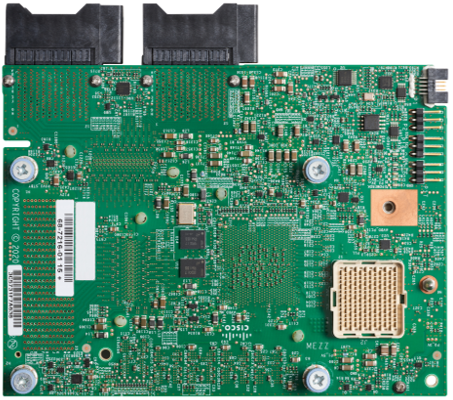
Cisco UCS VIC 14825
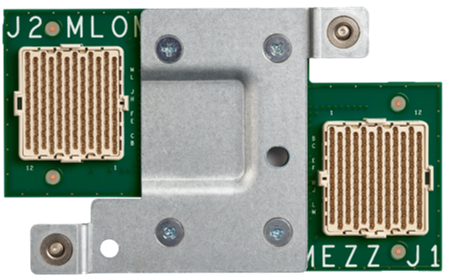
Cisco UCS VIC 14000 bridge connect
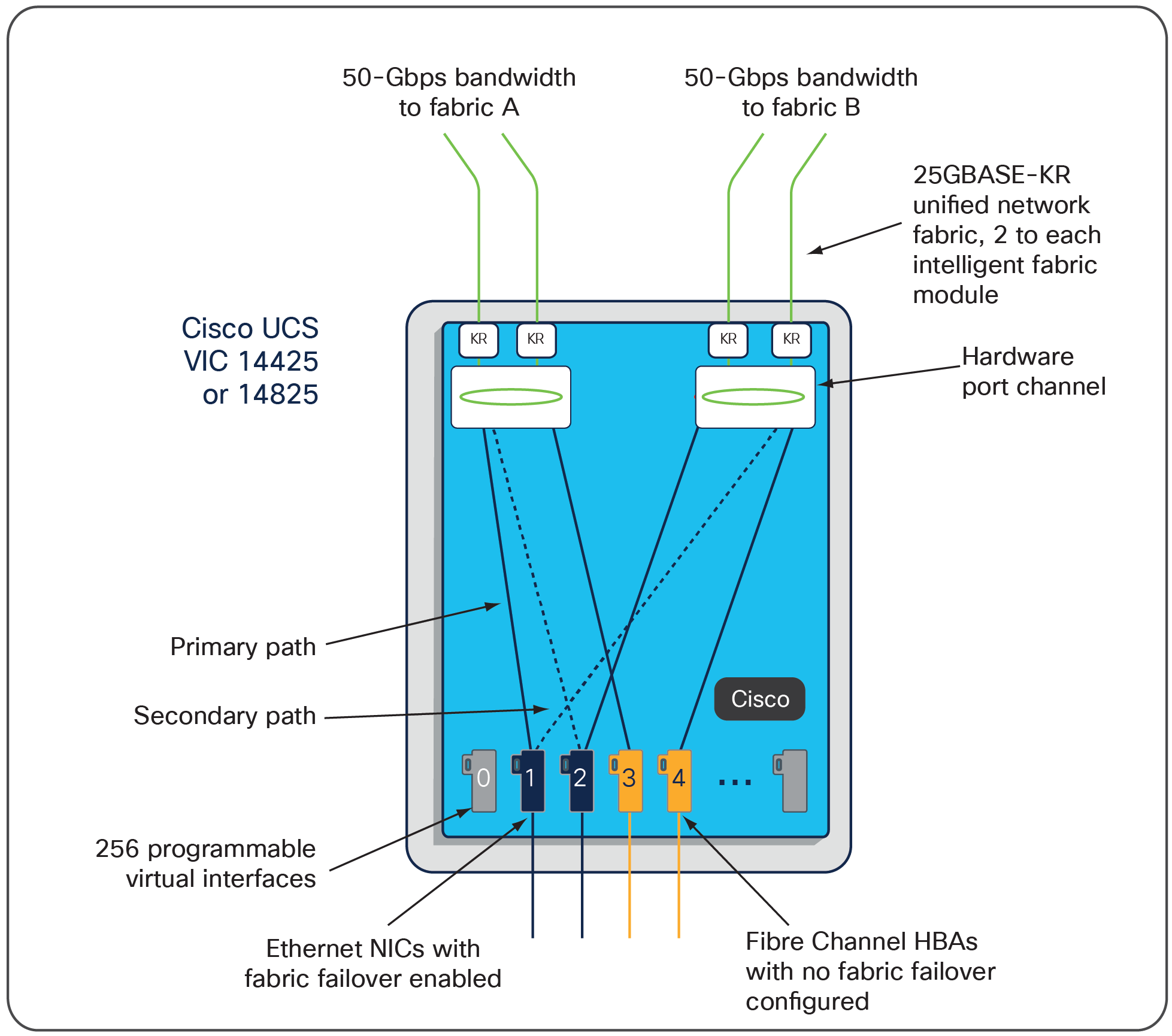
Cisco UCS VIC 14825 Infrastructure
Cisco VIC 1455
The Cisco UCS VIC 1455 (Figure 13) is a quad-port Small Form-Factor Pluggable (SFP28) half-height PCIe card designed for Cisco UCS C-Series M5 and M6 Rack Servers. The card supports 10/25-Gbps Ethernet or FCoE. The card can present PCIe standards-compliant interfaces to the host, and these can be dynamically configured as either NICs or HBAs.
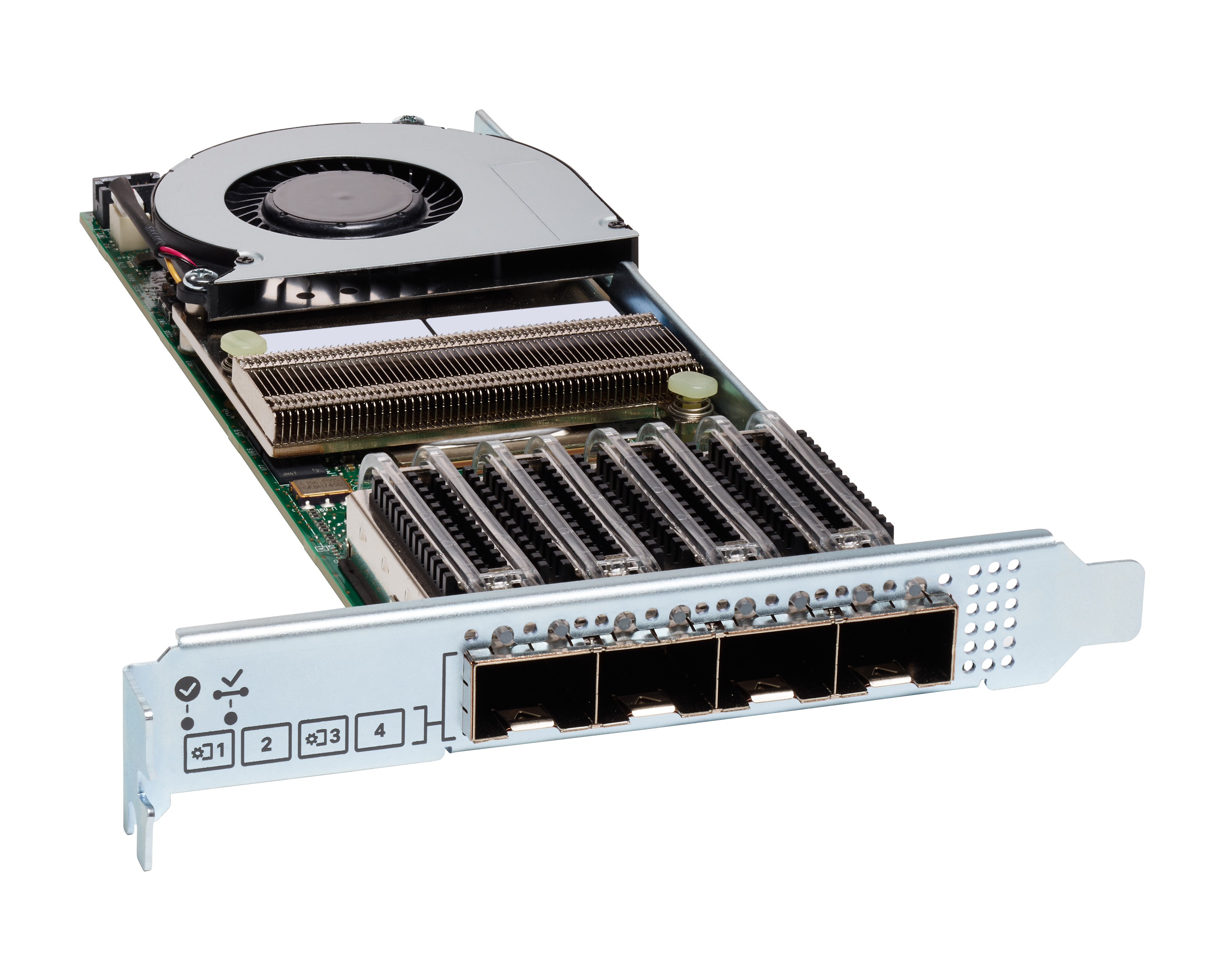
Cisco UCS VIC 1455
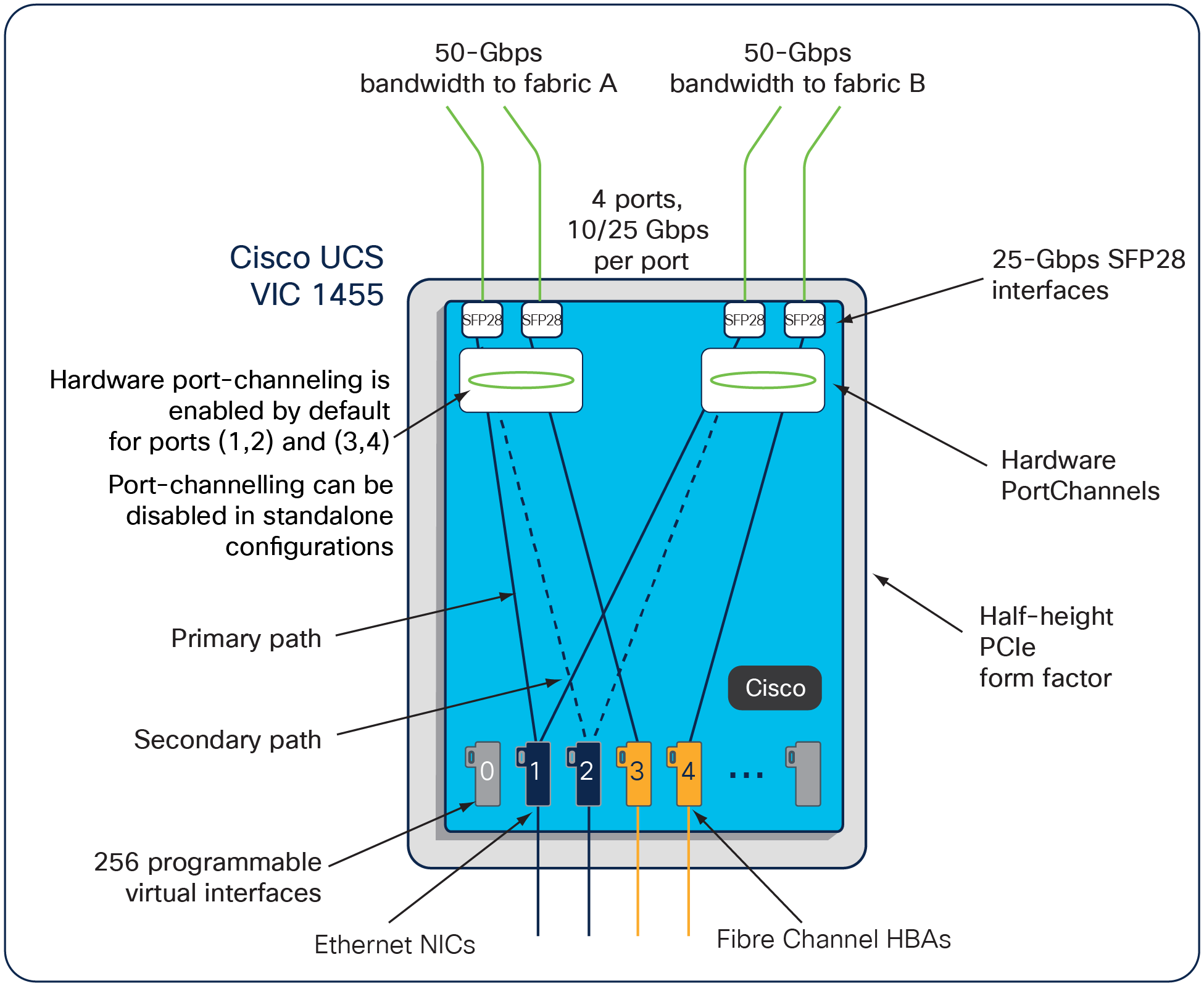
Cisco UCS VIC 1455 Infrastructure
Cisco VIC 1457
The Cisco UCS VIC 1457 (Figure 15) is a quad-port Small Form-Factor Pluggable (SFP28) mLOM card designed for Cisco UCS C-Series M5 Rack Servers. The card supports 10/25-Gbps Ethernet or FCoE. The card can present PCIe standards-compliant interfaces to the host, and these can be dynamically configured as either NICs or HBAs.
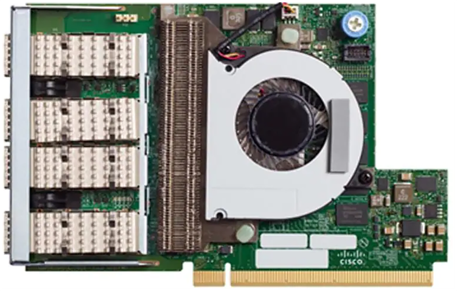
Cisco UCS VIC 1457
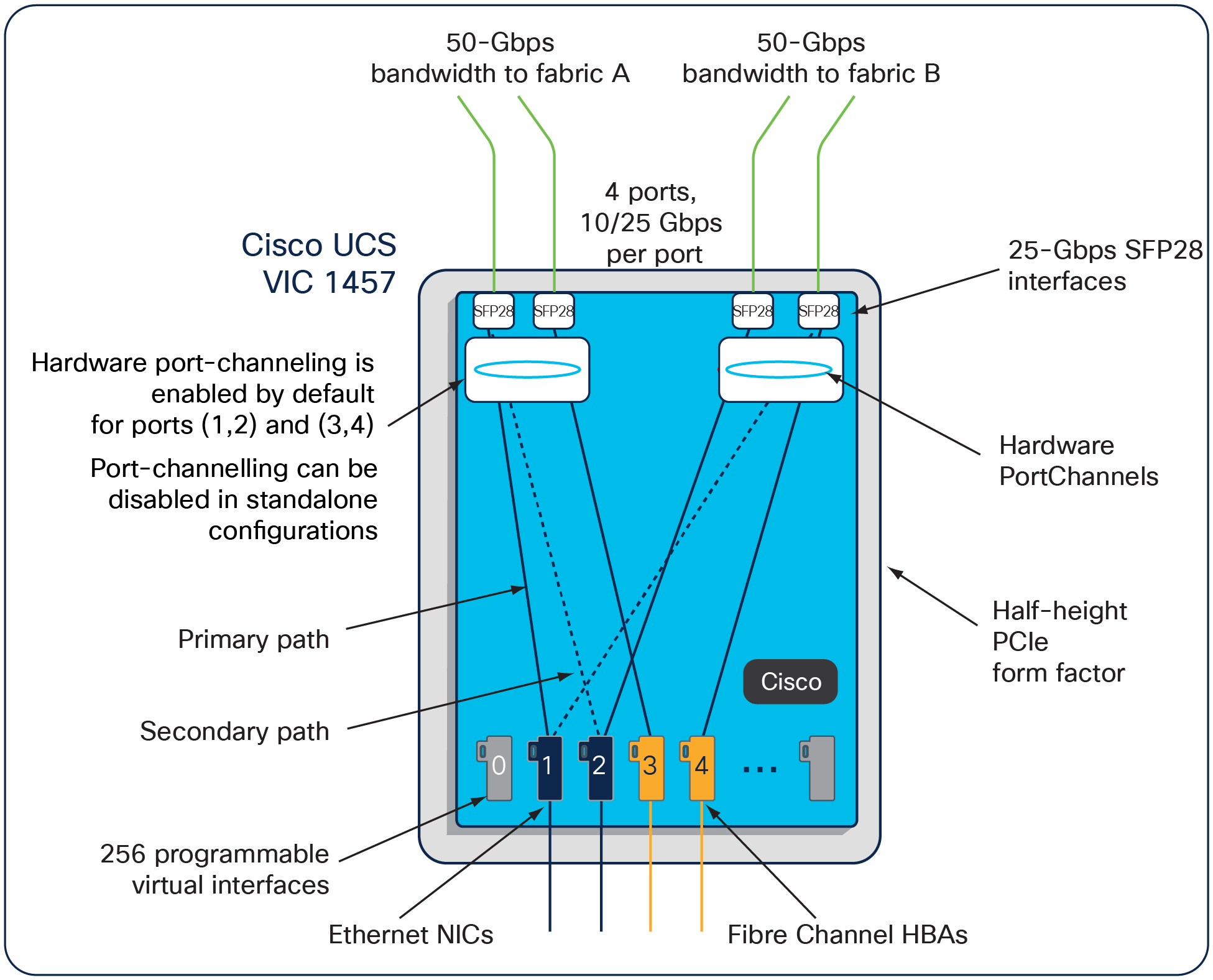
Cisco UCS VIC 1457 Infrastructure
Cisco VIC 1467
The Cisco UCS VIC 1467 (Figure 17) is a quad-port Small Form-Factor Pluggable (SFP28) mLOM card designed for Cisco UCS C-Series M6 Rack Servers. The card supports 10/25-Gbps Ethernet or FCoE. The card can present PCIe standards-compliant interfaces to the host, and these can be dynamically configured as either NICs or HBA.
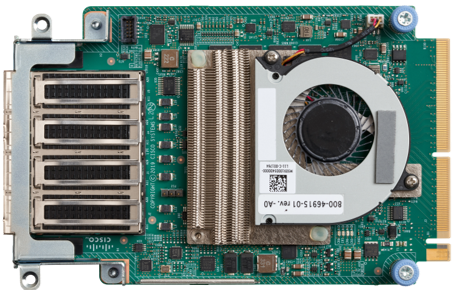
Cisco UCS VIC 1467
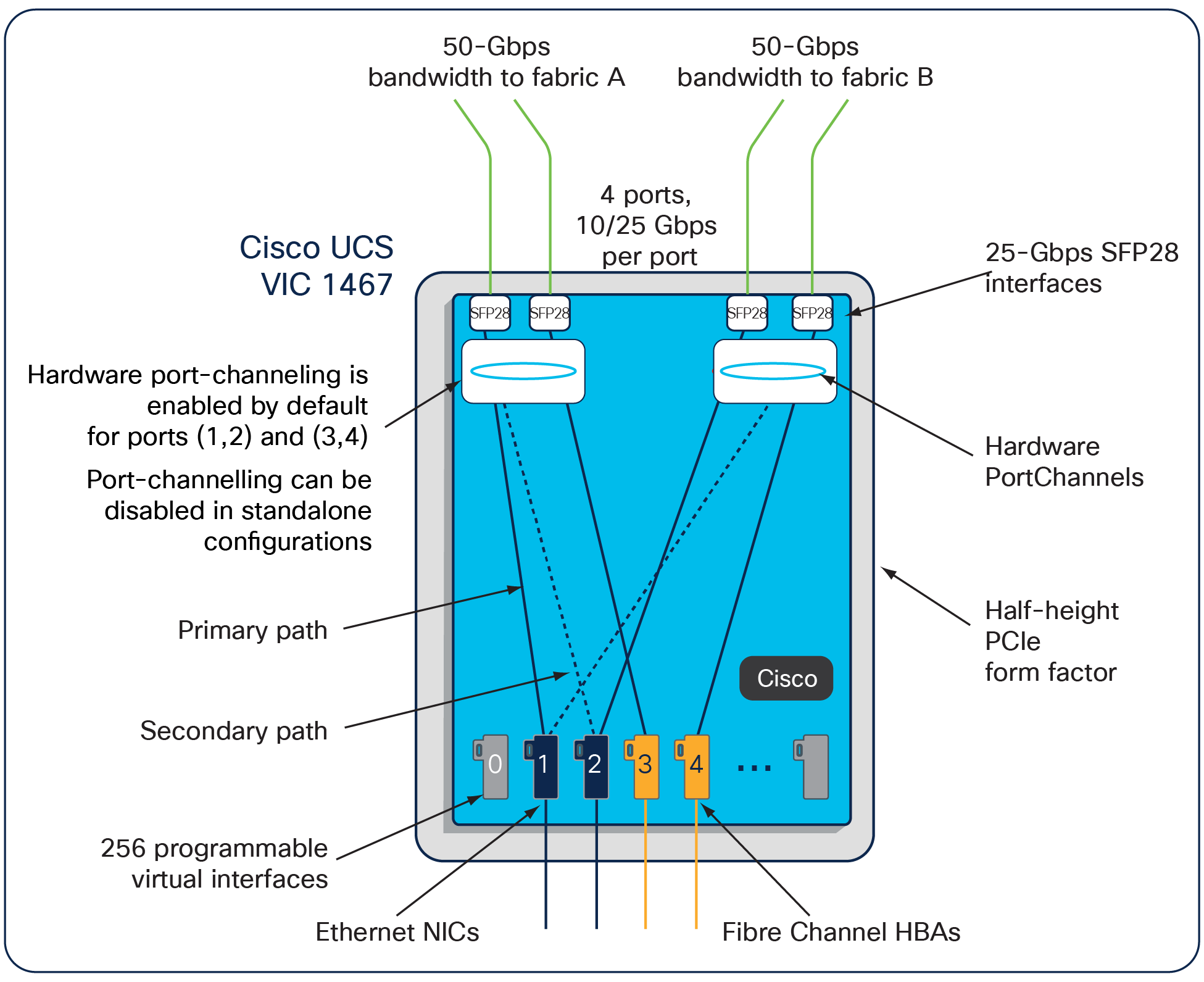
Cisco UCS VIC 1467 Infrastructure
Cisco VIC 1495
The Cisco VIC 1495 (Figure 19) is a dual-port Quad Small Form-Factor (QSFP28) PCIe card designed for Cisco UCS C-Series M5 and M6 Rack Servers. The card supports 40/100-Gbps Ethernet or FCoE. The card can present PCIe standards-compliant interfaces to the host, and these can be dynamically configured as NICs or HBAs.
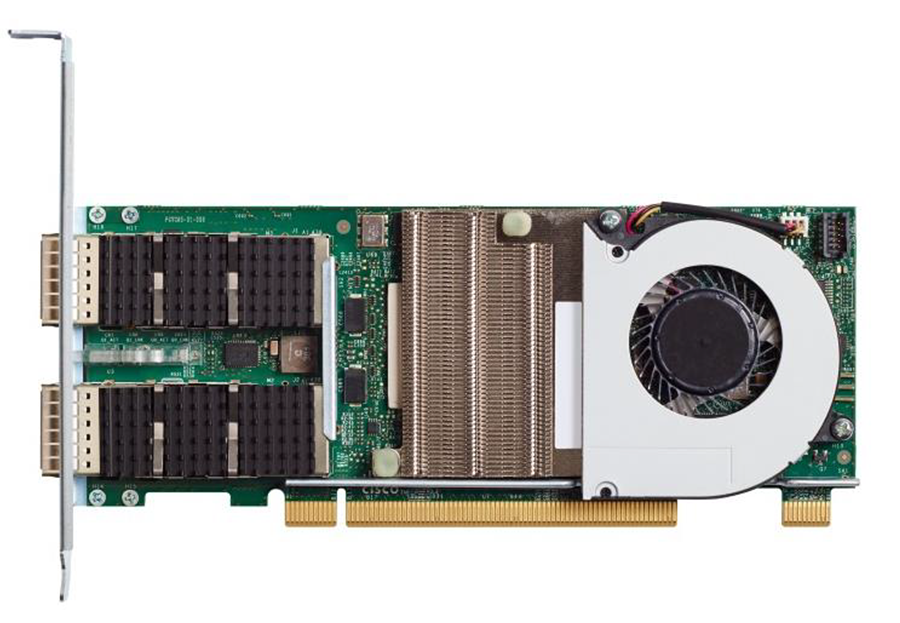
Cisco UCS VIC 1495
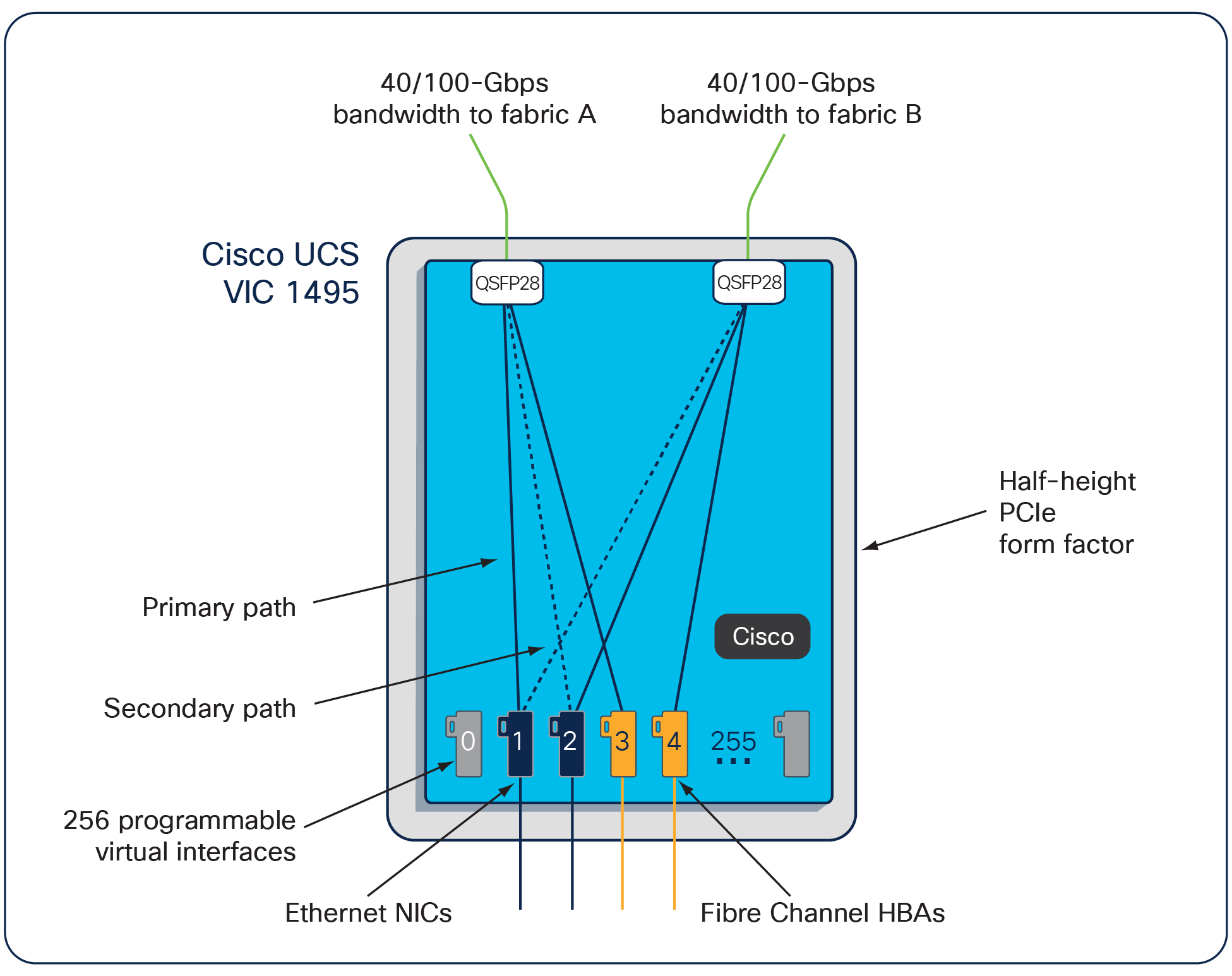
Cisco UCS VIC 1495 Infrastructure
Cisco VIC 1497
The Cisco VIC 1497 (Figure 21) is a dual-port Quad Small Form-Factor (QSFP28) mLOM card designed for Cisco UCS C-Series M5 Rack Servers. The card supports 40/100-Gbps Ethernet or FCoE. The card can present PCIe standards-compliant interfaces to the host, and these can be dynamically configured as NICs or HBAs.
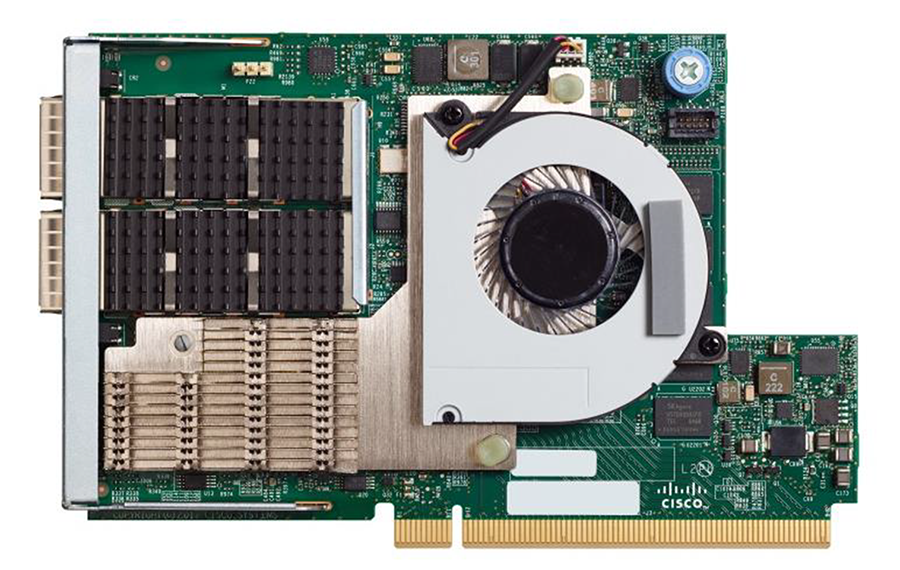
Cisco UCS VIC 1497
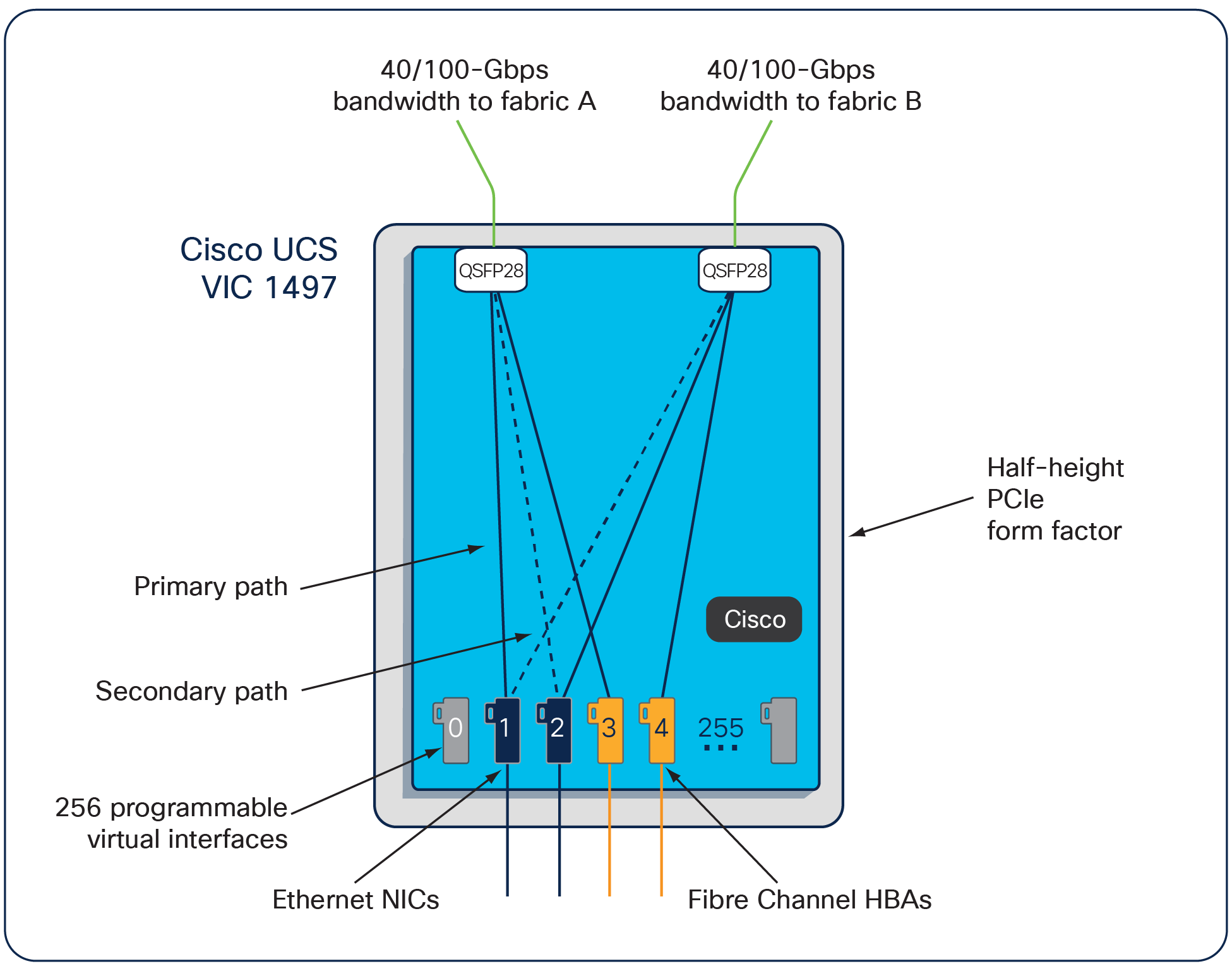
Cisco UCS VIC 1497 Infrastructure
Cisco VIC 1477
The Cisco VIC 1477 (Figure 23) is a dual-port Quad Small Form-Factor (QSFP28) mLOM card designed for Cisco UCS C-Series M6 Rack Servers. The card supports 40/100-Gbps Ethernet or FCoE. The card can present PCIe standards-compliant interfaces to the host, and these can be dynamically configured as NICs or HBAs.
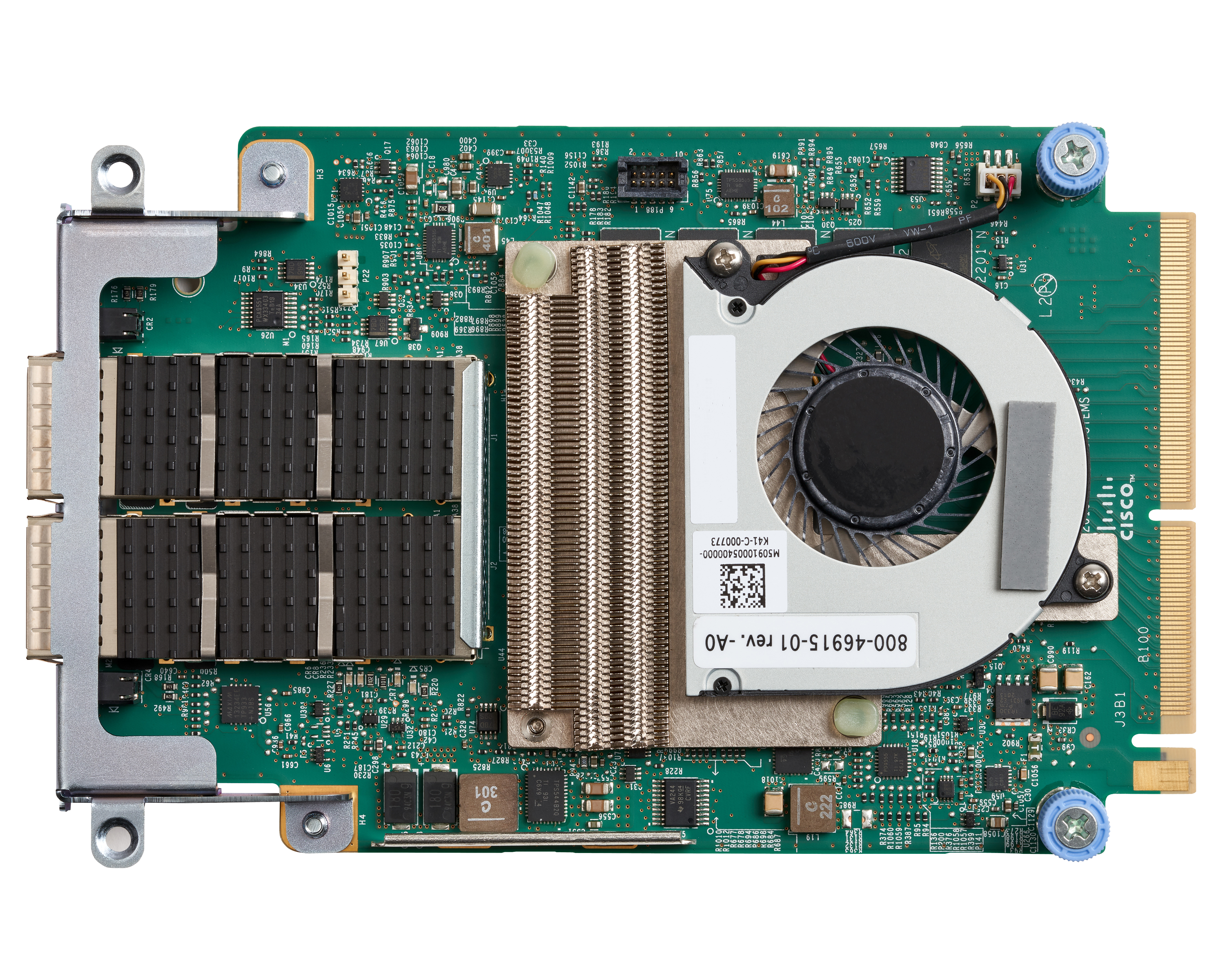
Cisco UCS VIC 1477
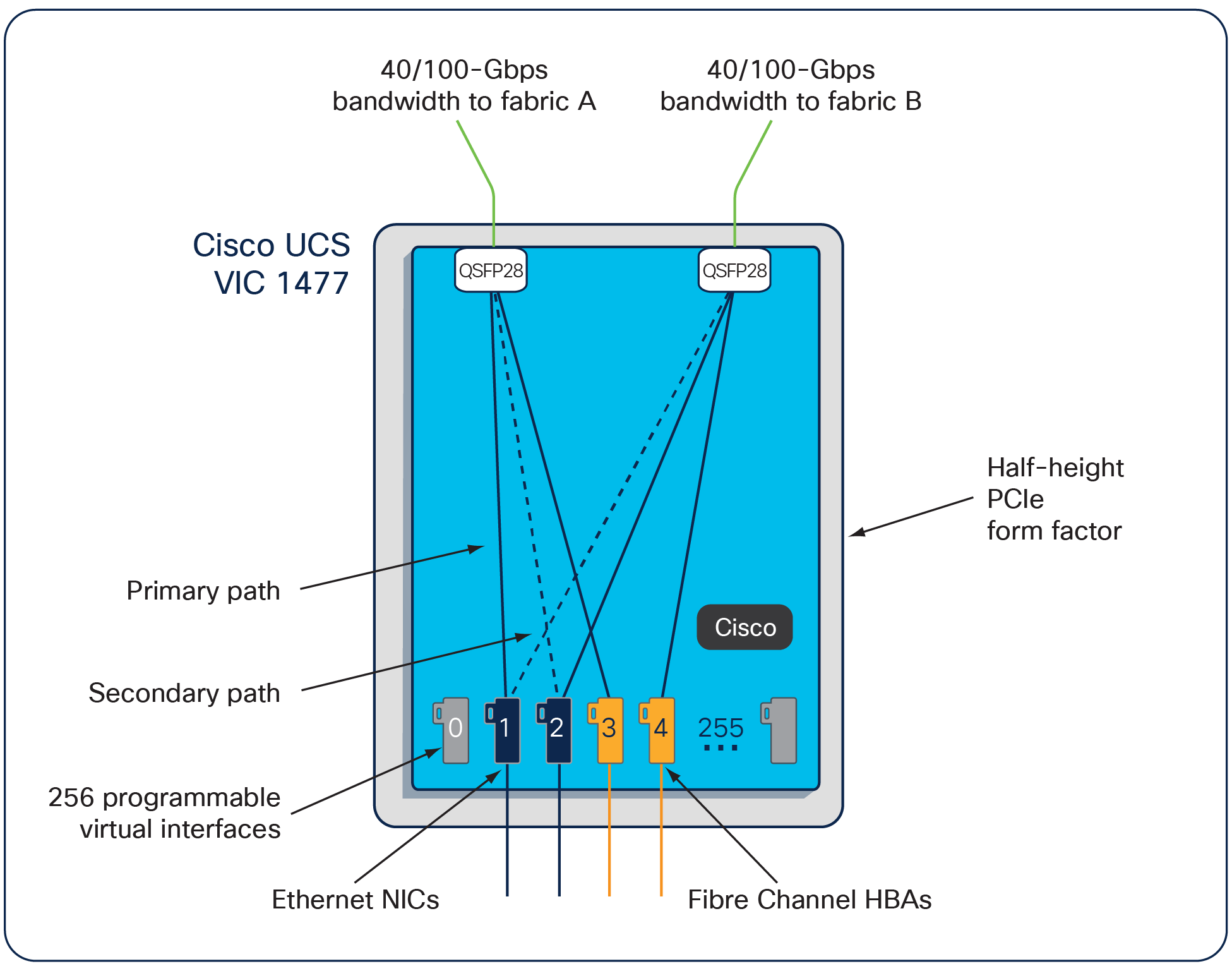
Cisco UCS VIC 1477 Infrastructure
The Cisco UCS VIC 1400/14000 series provides the following features and benefits:
● Stateless and agile platform: The personality of the card is determined dynamically at boot time using the service profile associated with the server. The number, type (NIC or HBA), identity (MAC address and World Wide Name [WWN]), failover policy, bandwidth, and Quality-of-Service (QoS) policies of the PCIe interfaces are all determined using the service profile. The capability to define, create, and use interfaces on demand provides a stateless and agile server infrastructure.
● Network interface virtualization: Each PCIe interface created on the VIC is associated with an interface on the Cisco UCS fabric interconnect, providing complete network separation for each virtual cable between a PCIe device on the VIC and the interface on the Fabric Interconnect.
Next-generation data center features
A hardware classification engine provides support for advanced data center requirements, including stateless network offloads for GENEVE, VXLAN and NVGRE. Additional features support low latency kernel bypass for performance optimization via usNIC, DPDK, and server virtualization support using NetQueue and VMQ/VMMQ. The Cisco UCS VIC 1400/14000 series provides high network performance and low latency for the most demanding applications:
● Big data, High-Performance Computing (HPC)
● Large-scale virtual machine deployments
● High-bandwidth storage targets and archives
When the Cisco UCS VIC 1400/14000 Series is connected to Cisco Nexus 9000 Series Switches, pools of virtual hosts scale with greater speed and agility. Cisco Nexus 9000 Series Switches provide native FCoE connectivity from the VIC to both Ethernet and Fibre Channel targets.
The Cisco VIC provides industry-leading performance and features.
Table 1 summarizes the main features and benefits of the Cisco UCS VIC 1400/14000 Series.
Table 1. Features and benefits
| Features |
Benefits |
| PCIe x16 Gen3 interfaces |
Delivers high performance (128 Gb/s) throughput |
| 10/25/40/100-Gbps unified I/O |
● Delivers 4x10/25-Gbps in a single VIC configuration with the Cisco UCS C-Series M5 and M6 Rack Server, and S-Series M5 Rack Server
● Delivers 2x40/100-Gbps in a single VIC configuration with the Cisco C-Series M5 and M6 Rack Server
● Helps reduce TCO by consolidating the overall number of NICs, HBAs, cables, and switches because LAN and SAN traffic run over the same adapter card and fabric
|
| 256 dynamic virtual adapters and interfaces |
● Creates fully functional unique and independent PCIe adapters and interfaces (NICs and HBAs) without requiring single-root I/O virtualization (SR-IOV) support from OSes or hypervisors
● Allows these virtual interfaces and adapters to be configured and operated independently, just like physical interfaces and adapters
● Creates a highly flexible I/O environment needing only one card for all I/O configurations
Note: Cisco UCS VIC 1400/14000 series hardware is SR-IOV capable. Please refer to Cisco UCS Manager configuration limits for your specific OS and environment in the configuration guide. |
| Low-latency connectivity |
Supports usNIC technology, delivering latency as low as 1 microsecond in back-to-back VIC connections; standard latency using the Cisco Nexus Series Switches in approximately 1-2 microseconds |
| Cisco SingleConnect technology |
A single unified network: the same network brings LAN, SAN, and management connectivity to each server |
| Cisco Data Center VM-FEX technology |
● Unifies virtual and physical networking in a single infrastructure
● Provides virtual machine visibility from the physical network and a consistent network operating model for physical and virtual servers
● Enables configurations and policies to follow the virtual machine during virtual machine migration
|
| Centralized management |
Enables the VIC card in B-/X-/C-/S-Series to be centrally managed and configured by Cisco UCS Manager or Intersight |
| Support for advanced features |
● SR-IOV
● usNIC
● Small Computer System Interface over IP (iSCSI) and iSCSI boot
● Ethernet NIC (eNIC) and Fibre Channel NIC (fNIC)
● VM-FEX support for KVM with RHEL
● Microsoft System Center Virtual Machine Manager (SCVMM)
● DPDK
● NetFlow
● N-Port ID Virtualization (NPIV)
● Receive Flow Steering
● Extended Receive (RX) Ring
● VMware NetQueue
● Windows VMQ/VMMQ
● Multi-RQ
● Receive Side Scaling (IPv4/IPv6/UDP/TCP)
● GENEVE support with VMware NSX-T, VXLAN and NVGRE
● NVME over RDMA support with RHEL 7.7
● RoCEv2 support with Windows 2019 NDKPI Mode 1 and Mode 2 with IPv4 / IPv6 and Linux
|
| Fibre Channel |
● Supports FCoE Fibre Channel with 10e15 Bit Error Rate (BER) connected to Cisco Nexus 9000 Series Switches
● Supports NVMe capabilities by adding NVMe over Fabrics (NVMeoF) with RoCEv2 addition to existing support for NVMe over Fabrics using Fibre Channel (FC-NVMe)
● FC-NVMe with SLES SP12 SP3/SP4, SLES 15, SLES 15 SP1, RHEL 7.6, RHEL 7.8, RHEL 7.9, RHEL 8.2, and ESXi 7.0
|
| Network architecture |
Provides a redundant path to the Fabric Interconnect using hardware-based fabric failover |
| High performance I/O |
Supports 900,000+ I/O Operations Per Second (IOPS) |
| Lossless Ethernet |
Uses Priority Flow Control (PFC) to enable as part of the Cisco Unified Fabric |
| Broad OS and hypervisor support |
Supports customer requirements for VMware vSphere, Microsoft Windows, Red Hat Enterprise Linux, Citrix XenServer, SUSE Linux Enterprise Server, and Ubuntu. Refer to the Hardware Compatible List (HCL) for detail list of supported operating systems |
Table 2 lists the specifications for the Cisco UCS VIC 1400/14000 Series.
Table 2. Cisco UCS VIC 1400/14000 Series specifications
| Items |
Specifications |
|
● 10-Gigabit Ethernet
● 25-Gigabit Ethernet
● 40-Gigabit Ethernet
● 100-Gigabit Ethernet
● IEEE 802.3x
● IEEE 802.1q VLAN
● IEEE 802.1p
● IEEE 802.1Qaz
● IEEEE 802.1Qbb
● Prestandard IEEE 802.1BR
● Jumbo frames up to 9KB
● SCSI-FCP
● T11 FCoE
|
|
| Components |
Cisco UCS custom Application-Specific Integrated Circuit (ASIC) |
| VIC 1495/1497/1477 physical ports |
2 x 40/100-Gbps Ethernet and FCoE QSFP28 |
| VIC 1455/1457/1467 physical ports |
4x10/25-Gbps Ethernet and FCoE SFP28 |
| Connectivity |
PCIe 3.0x16 form factor (PCIe, mLOM, and mezz) |
| Performance |
10/25/40/100-Gbps per port |
| Management |
Software release: Release 4.1(x) extends support for RoCEv2 Cisco VIC 1455/1457/1495/1497: Recommended UCSM Release is 4.0(4e) or later that contains VIC firmware 5.0(3d) or later and Recommended Standalone Release is 4.0(4h) or later that contains VIC firmware 5.0.3(d) or later. Review Note under Table 2 for minimum version required |
| Number of interfaces |
256 virtual interfaces (approximately eight are reserved for internal use; other factors such as the OS and hypervisor may limit this number further) |
| Supported switches with VIC 1455/1457/1467 |
Cisco Fabric Interconnect and Cisco Nexus switches:
● Cisco UCS-FI-6536 (support with minimum IMM Release 4.2(2))
● Cisco UCS-FI-64108 (support with minimum UCSM Release 4.1(1a))
● Cisco UCS-FI-6454
● Cisco UCS-FI-6332-16UP
● Cisco UCS-FI-6332
● Cisco UCS-FI-6248 (not supported on VIC 1467)
● Cisco UCS-FI-6296 (not supported on VIC 1467)
● Cisco Nexus 93180YC-FX3 (support in FEX mode with minimum UCSM Release 4.2(1))
● Cisco Nexus 2232PP
● Cisco Nexus 2348UPQ
● Cisco Nexus 31108PC-V
● Cisco Nexus 3172PQ
● Cisco Nexus 3232C
● Cisco Nexus 3548P-10GX
● Cisco Nexus 36180YC-R
● Cisco Nexus 5548UP
● Cisco Nexus 5624Q
● Cisco Nexus 5648Q
● Cisco Nexus 5672UP-16G
● Cisco Nexus 5696Q
● Cisco Nexus 92160YC-X
● Cisco Nexus 92300YC
● Cisco Nexus 9236C
● Cisco Nexus 9336C-FX2
● Cisco Nexus 9372PX
● Cisco Nexus 93180LC-EX
● Cisco Nexus 93180YC-EX
● Cisco Nexus 93180YC-FX
● Cisco Nexus 93240YC-FX2
● Cisco Nexus 93360YC-FX2 (support from Cisco IMC Release 4.2(2))
● Cisco Nexus 9316D-GX (support at 25G from Cisco IMC Release 4.2(2))
● Cisco Nexus 93108TC-FX (qualified with SFP-10G-T-X from Cisco IMC Release 4.2(1))
● Cisco Nexus 93108TC-EX (qualified with SFP-10G-T-X from Cisco IMC Release 4.2(1))
|
| Supported switches with VIC 1495/1497/1477 |
● Cisco UCS-FI-6536 (support with minimum IMM Release 4.2(2))
● Cisco UCS-FI-6332-16UP
● Cisco UCS-FI-6332
● Cisco Nexus 3232C
● Cisco Nexus 92300YC
● Cisco Nexus 9236C
● Cisco Nexus 93180LC-EX
● Cisco Nexus 93240YC-FX2
● Cisco Nexus 9332C (support from Cisco IMC Release 4.2(2))
● Cisco Nexus 9336C-FX2
● Cisco Nexus 93360YC-FX2 (support from Cisco IMC Release 4.2(2))
● Cisco Nexus 9364C
|
| Supported Fabric Interconnect and IOM with VIC 1440/1480 |
Cisco Fabric Interconnect switches and IOM:
● Cisco UCS-FI-6536 (support with minimum IMM Release 4.2(2))
● Cisco UCS-FI-64108 (support with minimum UCSM Release 4.1(1a))
● Cisco UCS FI-6454
● Cisco UCS-FI-6332-16UP
● Cisco UCS-FI-6332
● Cisco UCS-FI-6324 (UCS Mini)
● Cisco UCS-FI-6248
● Cisco UCS-FI-6296
● Cisco UCS-IOM-2408
● Cisco UCS-IOM-2304
● Cisco UCS-IOM-2208
● Cisco UCS-IOM-2204
|
| Supported Fabric Interconnect and IOM with VIC 14425/14825 |
Cisco Fabric Interconnect switches and IOM:
● Cisco UCS-FI-6536 (support with minimum IMM Release 4.2(2))
● Cisco UCS-FI-64108
● Cisco UCS FI-6454
● Cisco UCSX-I-9108-25G
● Cisco UCSX-I-9108-100G (supported with FI-6536)
|
VIC14425/14825: Minimum UCSM Release 4.2(1).
VIC1467/1477: Minimum UCSM Release 4.2(1) Standalone Cisco IMC Release 4.2(1).
VIC 1455/1457: Minimum UCSM Release Is 4.0(1a) with VIC firmware 5.0(1c) or later. Whereas the minimum Standalone Release is 4.0(1a) with VIC firmware 5.0(1c).
VIC 1495/1497: Minimum UCSM Release Is 4.0(2c) with VIC firmware 5.0(2b) or later. Whereas the minimum Standalone Release is 4.0(2) with VIC firmware 5.0(2b).
UCS Manager Release 4.1 support NVMeoF with RDMA for RoCEv2 on all VIC 1400/14000 series.
VIC 1440 + PE support with IOM 2408 (will support 40G aggregate flow and maximum 25G single flow per vNIC) with UCSM 4.1(2a).
Note that VIC 1457/1467/1455 supports 4x10G/4x25Gb breakout connectivity with upstream ToR switch with IMC.
In addition VIC 1457/1467/1455 supports 4x10G breakout with 6300 series FI, 4x10G/25G breakout with 6400 series FI and 4x25G breakout with 6536 FI.
Meanwhile, with VIC 1477/1495/1497 there is no reverse-breakout support of the 40/100G ports on these VICs to 4x10G/4x25G.
All the listed switches are validated against our Transceivers/Cables, any switch that is not listed is expected to work but not validated.
Table 3. Power and physical specification
| Items |
Specifications |
|||
| Cisco UCS VIC |
Power consumption (max) |
|||
| 1455 |
27.4W |
|||
| 1457 |
27.4W |
|||
| 1467 |
25.5W |
|||
| 1440 |
21W |
|||
| 1480 |
21W |
|||
| 14425 |
24.8W |
|||
| 14825 |
42.4W |
|||
| 1495 |
28W |
|||
| 1497 |
28W |
|||
| 1477 |
27.9W |
|||
| Cisco UCS VIC |
Length |
Width |
Height |
|
| 1455 |
6.60 in |
2.5 in |
0.53 in |
|
| 1457 |
5.75 in |
3.7in |
0.63 in |
|
| 1467 |
6.26 in |
3.99 in |
0.74 in |
|
| 1440 |
5.85 in |
3.4 in |
0.96 in |
|
| 1480 |
5.85 in |
2.9 in |
1.33 in |
|
| 14425 |
4.29 in |
5.03 in |
1.47 in |
|
| 14825 |
5.71 in |
5.19 in |
1.47 in |
|
| 1495 |
6.60 in |
2.5 in |
0.53 in |
|
| 1497 |
5.75 in |
3.7 in |
0.63 in |
|
| 1477 |
6.29 in |
3.99 in |
0.74 in |
|
Table 4. Cisco UCS VICs, Fabric Interconnect, IOM, and Server Support
| Cisco UCS VIC |
Cisco UCS Servers |
| 1440 10/40-Gbps mLOM |
B200 M5/M6, B480 M5 |
| 1480 10/40-Gbps mezz |
B200 M5/M6, B480 M5 |
| 14425 quad-port 25G mLOM |
X210c M6 |
| 14825 quad-port 25G mezz |
X210c M6 |
| 1455 quad-port 10/25-Gbps PCIe |
C125 M5, C220 M5/M6, C225 M6, C240 M5/M6, C240 SD M5, C245 M6, C480 M5, C480 ML M5, C4200, S3260 M5 |
| 1457 quad-port 10/25-Gbps mLOM |
C220 M5, C240 M5, C240 SD M5 |
| 1467 quad-port 10/25-Gbps mLOM |
C220 M6, C240 M6, C225 M6, C245 M6 |
| 1495 dual-port 40/100-Gbps PCIe |
C125 M5, C220 M5/M6, C225 M6, C240 M5/M6, C240 SD M5, C245 M6, C480 M5, C480 ML M5, C4200, S3260 M5 |
| 1497 dual-port 40/100-Gbps mLOM |
C220 M5, C240 M5, C240 SD M5 |
| 1477 dual-port 40/100-Gbps mLOM |
C220 M6, C240 M6, C225 M6, C245 M6 |
Transceiver and cable support
The Cisco UCS VIC supports a wide variety of Ethernet connectivity options using Cisco 10/25/40/100-Gbps transceivers and 10/25/40/100-Gbps passive cables and active optical cables.
Third party cables and transceivers are not supported by the Cisco UCS C-series VICs and the link would not come up if they are used to connect VIC to a Fabric Interconnect or to a ToR switch like Nexus 9K. Hence when connecting C-series VIC to Fabric Interconnect or a ToR switch only the supported transceivers and cables listed below should be used.
Table 5 lists the supported transceiver options.
Table 5. Cisco UCS VIC transceiver matrix
| Product number |
Description |
| SFP+ 10-Gbps transceivers(16) |
|
| SFP-10G-T-X(14) |
10GBASE-T, Copper, 30m |
| SFP-10G-SR |
10GBASE-SR, 850 nm, MMF, 300m |
| SFP-10G-SR-S |
10GBASE-SR, 850 nm, MMF, 300m, S-Class |
| SFP-10G-LR |
10GBASE-LR, 1310 nm, SMF, 10 km |
| SFP-10G-LR-S |
10GBASE-LR, 1310 nm, SMF, 10 km, S-Class |
| MA-SFP-10GB-SR(13) |
10GBASE-SR, 850 nm, MMF, 300m |
| MA-SFP-10GB-LR(13) |
10GBASE-LR, 1310 nm, SMF, 10km |
| SFP28 25-Gbps transceivers |
|
| SFP-25G-SR-S(15) |
25GBASE-SR SFP28 Module for MMF |
| SFP-25G-SL(15) |
25GBASE-SL SFP28 module for MMF |
| SFP-10/25G-CSR-S(1) (15) |
10/25GBASE-CSR SFP28 Module for MMF |
| SFP-10/25G-LR-S(8) (15) |
10/25GBASE-LR SFP28 Module of SMF |
| QSFP 40-Gbps transceivers |
|
| QSFP-40G-SR4(18) |
40GBASE-SR, 850 nm, MMF, 300 m |
| QSFP-40G-SR4-S(18) |
40GBASE-SR, 850 nm, MMF, 300 m, S-Class |
| QSFP-40G-CSR4(18) |
40GBASE-CSR4, 4 lanes, 850 nm MMF |
| QSFP-40G-LR4(18) |
40GBASE-LR, 1310 nm, SMF, 10 km |
| QSFP-40G-LR4-S(18) |
40GBASE-LR, 1310 nm, SMF, 10 km, S-Class |
| QSFP-40G-SR-BD |
40GBASE-SR-BiDi, duplex MMF, 150 m |
| WSP-Q40GLR4L(2) |
40GBASE-LR4-Lite, 1310 nm, SMF, 2 km |
| QSFP28 100-Gbps transceivers |
|
| QSFP-100G-SR4-S |
100GBASE-SR, 850 nm, MMF, 300 m, MPO, S-Class |
| QSFP-40/100-SRBD(3) |
100G and 40GBASE SR-BiDi QSFP, MMF, LC, 100 m |
| QSFP-100G-SR1.2(19) |
100G SR-BiDi QSFP Transceiver, LC, 100m OM4 MMF, LC |
| QSFP-100G-LR4-S |
100GBASE-LR, 1310 nm, SMF, 10 km, LC, S-Class |
| QSFP-100G-SL4 |
100GBASE QSFP Short Link Transceivers, 30M reach over OM4 MMF, MPO |
| QSFP-100G-DR-S(20) |
100GBASE DR QSFP Transceiver, 500m over SMF, LC |
| QSFP-100G-FR-S(20) |
100GBASE FR QSFP Transceiver, 2km over SMF, LC |
| QSFP-100G-SM-SR(21) |
100GBASE CWDM4 Lite QSFP Transceiver, 2km over SMF, 10-60C, LC |
| QSFP-100G-CWDM4-S(22) |
100GBASE CWDM4 QSFP Transceiver, LC, 2km over SMF, LC |
| QSFP-100G-PSM4-S(23) |
|
Note:
Qualified transceiver optical breakout using 3rd party MPO-4xLC fiber breakout cable
● SFP-10G-SR to QSFP-40G-SR4 in 4x10G breakout mode with fabric-interconnect and standalone switches.
● SFP-10G-SR to QSFP-40G-CSR4 in 4x10G breakout mode with fabric-interconnect and standalone switches.
● SFP-10G-LR-S to QSFP-4x10G-LR-S in 4x10G breakout mode with standalone switches.
● SFP-25G-SR-S to QSFP-100G-SR4-S in 4x25G mode breakout mode with fabric-interconnect and standalone switches.
● SFP-10/25G-CSR-S to QSFP-100G-SR4-S in 4x25G mode breakout mode with fabric-interconnect and standalone switches.
● SFP-10/25G-LR-S to QSFP-100G-PSM4-S in 4x25G mode breakout mode with standalone switches.
● SFP-25G-SL to QSFP-100G-SL4 in 4x25G mode breakout mode with fabric-interconnect and standalone switches.
Table 6. Cisco UCS VIC cable support matrix
| Product number |
Description |
| SFP+ 10-Gbps cables with integrated transceivers(16) |
|
| SFP-H10GB-CU1M |
10GBASE-CU SFP+ direct-attached copper cable, 1M |
| SFP-H10GB-CU1-5M(4) |
10GBASE-CU SFP+ direct-attached copper cable, 1.5M |
| SFP-H10GB-CU2M |
10GBASE-CU SFP+ direct-attached copper cable, 2M |
| SFP-H10GB-CU2-5M(4) |
10GBASE-CU SFP+ direct-attached copper cable, 2.5M |
| SFP-H10GB-CU3M |
10GBASE-CU SFP+ direct-attached copper cable, 3M |
| SFP-H10GB-CU5M |
10GBASE-CU SFP+ direct-attached copper cable, 5M |
| MA-CBL-TA-1M(13) |
10GBASE-CU SFP+ direct-attached copper cable, 1M |
| MA-CBL-TA-3M(13) |
10GBASE-CU SFP+ direct-attached copper cable, 3M |
| SFP-H10GB-ACU7M |
10GBASE-CU SFP+ direct-attached active copper cable, 7M |
| SFP-H10GB-ACU10M |
10GBASE-CU SFP+ direct-attached active copper cable, 10M |
| SFP-10G-AOC1M |
10GBASE active optical SFP+ cable, 1M |
| SFP-10G-AOC2M |
10GBASE active optical SFP+ cable, 2M |
| SFP-10G-AOC3M |
10GBASE active optical SFP+ cable, 3M |
| SFP-10G-AOC5M |
10GBASE active optical SFP+ cable, 5M |
| SFP-10G-AOC7M |
10GBASE active optical SFP+ cable, 7M |
| SFP-10G-AOC10M |
10GBASE active optical SFP+ cable, 10M |
| SFP28 25-Gbps cables with integrated transceivers |
|
| SFP-H25G-CU1M |
25GBASE-CU SFP28 direct-attached copper cable, 1M |
| SFP-H25G-CU2M |
25GBASE-CU SFP28 direct-attached copper cable, 2M |
| SFP-H25G-CU3M |
25GBASE-CU SFP28 direct-attached copper cable, 3M |
| SFP-H25G-CU4M(6) |
25GBASE-CU SFP28 direct-attached copper cable, 4M |
| SFP-H25G-CU5M(7)(11)(12) |
25GBASE-CU SFP28 direct-attached copper cable, 5M |
| SFP-25G-AOC1M |
25GBASE-AOC SFP28 active optical cable, 1M |
| SFP-25G-AOC2M |
25GBASE-AOC SFP28 active optical cable, 2M |
| SFP-25G-AOC3M |
25GBASE-AOC SFP28 active optical cable, 3M |
| SFP-25G-AOC4M(9) |
25GBASE-AOC SFP28 active optical cable, 4M |
| SFP-25G-AOC5M |
25GBASE-AOC SFP28 active optical cable, 5M |
| SFP-25G-AOC7M |
25GBASE-AOC SFP28 active optical cable, 7M |
| SFP-25G-AOC10M |
25GBASE-AOC SFP28 active optical cable, 10M |
| QSFP 40-Gbps cables |
|
| QSFP-H40G-CU1M |
40GBASE-CR4 Passive Copper Cable, 1m |
| QSFP-H40G-CU3M |
40GBASE-CR4 Passive Copper Cable, 3m |
| QSFP-H40G-CU5M |
40GBASE-CR4 Passive Copper Cable, 5m |
| QSFP-H40G-ACU7M |
40GBASE-CR4 Active Copper Cable, 7m |
| QSFP-H40G-ACU10M |
40GBASE-CR4 Active Copper Cable, 10m |
| QSFP-H40G-AOC1M |
40GBASE Active Optical Cable, 1m |
| QSFP-H40G-AOC2M |
40GBASE Active Optical Cable, 2m |
| QSFP-H40G-AOC3M |
40GBASE Active Optical Cable, 3m |
| QSFP-H40G-AOC5M |
40GBASE Active Optical Cable, 5m |
| QSFP-H40G-AOC7M |
40GBASE Active Optical Cable, 7m |
| QSFP-H40G-AOC10M |
40GBASE Active Optical Cable, 10m |
| QSFP-H40G-AOC15M |
40GBASE Active Optical Cable, 15m |
| QSFP-H40G-AOC20M(4) |
40GBASE Active Optical Cable, 20m |
| QSFP-H40G-AOC25M(4) |
40GBASE Active Optical Cable, 25m |
| QSFP-H40G-AOC30M(4) |
40GBASE Active Optical Cable, 30m |
| QSFP-4x10G-AC7M(5)(10) |
40GBASE-CR4 QSFP+ to 4x10GBASE-CU SFP+ active direct-attach breakout cable, 7M |
| QSFP-4x10G-AC10M(5)(10) |
40GBASE-CR4 QSFP+ to 4x10GBASE-CU SFP+ active direct-attach breakout cable, 10M |
| QSFP-4SFP10G-CU1M(5)(10) |
40GBASE-CR4 QSFP+ to 4x10GBASE-CU SFP+ passive direct-attach cable, 1M |
| QSFP-4SFP10G-CU3M(5)(10) |
40GBASE-CR4 QSFP+ to 4x10GBASE-CU SFP+ passive direct-attach cable, 3M |
| QSFP-4SFP10G-CU5M(5)(10) |
40GBASE-CR4 QSFP+ to 4x10GBASE-CU SFP+ passive direct-attach cable, 5M |
| QSFP-4X10G-AOC1M(5)(10) |
40GBASE-active optical QSFP to 4xSFP+ active optical breakout cable, 1M |
| QSFP-4X10G-AOC2M(5) |
40GBASE-active optical QSFP to 4xSFP+ active optical breakout cable, 2M |
| QSFP-4X10G-AOC3M(5)(10) |
40GBASE-active optical QSFP to 4xSFP+ active optical breakout cable, 3M |
| QSFP-4X10G-AOC5M(5)(10) |
40GBASE-active optical QSFP to 4xSFP+ active optical breakout cable, 5M |
| QSFP-4X10G-AOC7M(5)(10) |
40GBASE-active optical QSFP to 4xSFP+ active optical breakout cable, 7M |
| QSFP-4X10G-AOC10M(5)(10) |
40GBASE-active optical QSFP to 4xSFP+ active optical breakout cable, 10M |
| QSFP 100-Gbps cables |
|
| QSFP-100G-CU1M (17) |
100GBASE-CR4 passive copper cable, 1M |
| QSFP-100G-CU2M (17) |
100GBASE-CR4 passive copper cable, 2M |
| QSFP-100G-CU3M (17) |
100GBASE-CR4 passive copper cable, 3M |
| QSFP-100G-CU5M (17) |
100GBASE-CR4 passive copper cable, 5M |
| QSFP-100G-AOC1M |
100GBASE QSFP Active Optical Cable, 1m |
| QSFP-100G-AOC2M |
100GBASE QSFP Active Optical Cable, 2m |
| QSFP-100G-AOC3M |
100GBASE QSFP Active Optical Cable, 3m |
| QSFP-100G-AOC5M |
100GBASE QSFP Active Optical Cable, 5m |
| QSFP-100G-AOC7M |
100GBASE QSFP Active Optical Cable, 7m |
| QSFP-100G-AOC10M |
100GBASE QSFP Active Optical Cable, 10m |
| QSFP-100G-AOC15M |
100GBASE QSFP Active Optical Cable, 15m |
| QSFP-100G-AOC20M |
100GBASE QSFP Active Optical Cable, 20m |
| QSFP-100G-AOC25M |
100GBASE QSFP Active Optical Cable, 25m |
| QSFP-100G-AOC30M |
100GBASE QSFP Active Optical Cable, 30m |
| QSFP-4SFP25G-CU1M(5)(10)(19) |
100GBASE QSFP to 4xSFP25G passive copper splitter cable, 1M |
| QSFP-4SFP25G-CU2M(5)(10)(19) |
100GBASE QSFP to 4xSFP25G passive copper splitter cable, 2M |
| QSFP-4SFP25G-CU3M(5)(10)(19) |
100GBASE QSFP to 4xSFP25G passive copper splitter cable, 3M |
| QSFP-4SFP25G-CU5M(5)(10)(19) |
100GBASE QSFP to 4xSFP25G passive copper splitter cable, 5M |
Note:
Table 7 presents ordering information for the Cisco UCS VIC 1400/14000 Series.
Table 7. Ordering information
| Part number |
Description |
| UCSB-MLOM-40G-04 |
Cisco UCS VIC 1440 mLOM for B-Series M5 and M6 |
| UCSB-VIC-M84-4P |
Cisco UCS VIC 1480 mezz for B-Series M5 and M6 |
| UCSX-V4-Q25GML |
UCS VIC 14425 4x25G mLOM for X Compute Node |
| UCSX-V4-Q25GME |
UCS VIC 14825 4x25G mezz for X Compute Node |
| UCSX-V4-BRIDGE |
UCS VIC 14000 bridge connector between mLOM and mezz for X Compute Node |
| UCSC-PCIE-C25Q-04 |
Cisco UCS VIC 1455 quad port 10/25G SFP28 PCIe for C220 M5/M6, C240 M5/M6, S3260 M5, C240 SD M5, C480 M5, C480 ML M5, C125 M5, S3260 M5, C225 M6, C245 M6 |
| UCSC-MLOM-C25Q-04 |
Cisco UCS VIC 1457 quad port 10/25G SFP28 mLOM for C220 M5, C240 M5 and C240 SD M5 |
| UCSC-M-V25-04 |
Cisco UCS VIC 1467 quad port 10/25G SFP28 mLOM for C220 M6, C240 M6, C225 M6, C245 M6 |
| UCSC-PCIE-C100-04 |
Cisco UCS VIC 1495 dual port 40/100G QSFP28 PCIe for C220 M5/M6, C240 M5/M6, S3260 M5, C240 SD M5, C480 M5, C480 ML M5, C125 M5, S3260 M5, C225 M6, C245 M6 |
| UCSC-MLOM-C100-04 |
Cisco UCS VIC 1497 dual port 40/100G QSFP28 mLOM for C220 M5, C240 M5, C240 SD M5 |
| UCSC-M-V100-04 |
Cisco UCS VIC 1477 dual port 40/100G QSFP28 mLOM for C220 M6, C240 M6, C225 M6, C245 M6 |
The Cisco UCS VIC 1400/14000 Series is designed for use on Cisco UCS B-Series M5 and M6 Blade Servers, C-Series M5 and M6 Rack Servers, X-Series M6 Servers and S-Series M5 Storage Servers.
Find warranty information at Cisco.com on the Product Warranties page.
Information about Cisco’s environmental, social, and governance (ESG) initiatives and performance is provided in Cisco’s CSR and sustainability reporting.
Table 8. Cisco environmental sustainability information
| Sustainability topic |
Reference |
|
| General |
Information on product-material-content laws and regulations |
|
| Information on electronic waste laws and regulations, including our products, batteries, and packaging |
||
| Information on product takeback and reuse program |
||
| Sustainability inquiries |
Contact: csr_inquiries@cisco.com |
|
| Standards |
||
| Power |
Power consumption |
|
| Material |
Product packaging weight and materials |
Contact: environment@cisco.com |
| Physical dimensions |
||
Cisco Unified Computing Services
Using a unified view of data center resources, Cisco and our industry-leading partners deliver services that accelerate your transition to a unified computing architecture. Cisco Unified Computing Services help you quickly deploy your data center resources, simplify ongoing operations, and optimize your infrastructure to better meet your business needs. For more information about these and other Cisco Data Center Services, visit https://www.cisco.com/go/unifiedcomputingservices.
The Cisco Unified Computing System continues Cisco’s long history of innovation in delivering integrated systems for improved business results based on industry standards and using the network as the platform. Recent examples include IP telephony, LAN switching, unified communications, and unified I/O. Cisco began the unified computing phase of our unified data center strategy several years ago by assembling an experienced team from the computing and virtualization industries to augment our own networking and storage access expertise. As a result, Cisco delivered foundational technologies, including the Cisco Nexus Family, supporting unified fabric and server virtualization. Cisco UCS completes this phase, delivering innovation in architecture, technology, partnerships, and services. Cisco is well positioned to deliver this innovation by taking a systems approach to computing that unifies network intelligence and scalability with innovative ASICs, integrated management, and standard computing components.
Flexible payment solutions to help you achieve your objectives
Cisco Capital makes it easier to get the right technology to achieve your objectives, enable business transformation and help you stay competitive. We can help you reduce the total cost of ownership, conserve capital, and accelerate growth. In more than 100 countries, our flexible payment solutions can help you acquire hardware, software, services and complementary third-party equipment in easy, predictable payments. Learn more.
For more information about Cisco UCS, visit https://www.cisco.com/en/US/products/ps10265/index.html.
| New or revised topic |
Described in |
Date |
| Added new transceiver matrix |
Where applicable |
October 20, 2022 |
| Updated 100G optics, Nexus 93180YC-FX3 compatibility |
July 2024 |